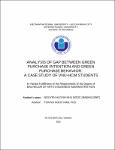| dc.description.abstract | Why do people say they want green products, but they do not tend to buy them?
This phenomenon is known as Green gap. Image Research Theory and Motivation
Opportunity-Ability Theory were used to build up the conceptual framework reflecting
sequencing relationships from green purchase intention, implementation intention, to green
purchase behavior with two moderators (e.g., action self-efficacy, coping self-efficacy).
Applying the quantitative research method, an online questionnaire survey was distributed
among Facebook users, who are students from 6 member universities of VNU-HCM with
with their preferential purchase, experiences and involvement in green products. A total of
233 valid copies then were analyzed and tested by PLS-SEM. The results supported the
significantly positive causal relationship between Green purchase intention,
Implementation intention, and Green purchase behavior. The study contributed to Green
gap literature in the Vietnamese context and provide practical implications to encourage
sustainable consumption of the younger generation. | en_US |


